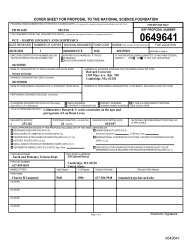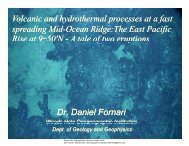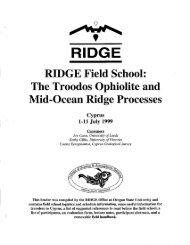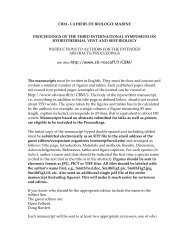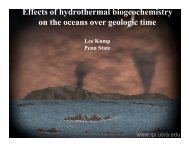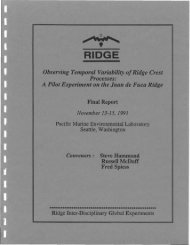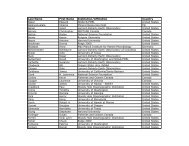You also want an ePaper? Increase the reach of your titles
YUMPU automatically turns print PDFs into web optimized ePapers that Google loves.
2. Characterization of Individual Segments and their<br />
Boundaries. Once the characteristics of segmentation are known<br />
in detail, it will be of great interest to determine the spatial<br />
and temporal stability of the segment. This includes possible<br />
cyclic or episodic interplay among volcanic and tectonic<br />
processes within a single segment as well as the dynamic<br />
interaction between individual segments focused at their<br />
boundaries. The nature of the lithosphere created by individual<br />
segments may vary along the strike of the segment and with time<br />
in a periodic or episodic manner as suggested by the diverse<br />
morphologies and petrologic characteristics of individual<br />
segments. Individual processes that must be understood are the<br />
nature of faulting and fissuring, the depth of the brittle to<br />
ductile transition, and the thermo-mechanical and stress<br />
characteristics of young lithosphere. In addition, it is<br />
necessary to better understand processes of magma generation,<br />
ascent, storage, eruption and intrusion and how these interact<br />
with tectonic processes within a segment. Are the deeper<br />
processes that control magma generation and spreading coherent<br />
over distances larger than a single segment- or do segments<br />
behave independently? If so, is this primarily due to the<br />
interaction of the upper mantle with the young and evolving<br />
lithosphere, or the termporal and spatial variability of upper<br />
mantle processes?<br />
3. Thermal and Mechanical Processes Affecting the<br />
Evolution of Oceanic Lithosphere. The oceanic lithosphere is<br />
defined as the cool, mechanically strong boundary layer that<br />
overlies weaker ductile mantle. A thorough understanding of the<br />
spreading process requires knowledge of the mechanisms affecting<br />
the creation and subsequent evolution of the lithosphere. It is<br />
first necessary to understand the cooling processes, including<br />
hydrothermal convection and thermal conduction, that cause the<br />
lithosphere to form and thicken. Simultaneously, distributed<br />
horizontal extension or stretching will thin the lithosphere.<br />
These processes will be interrelated: for example, the<br />
stretching process will create faults and fissures that will<br />
allow seawater to penetrate the crust and mantle. The<br />
importance of these processes emphasizes the need to understand<br />
the temporal and spatial distribution, both along and across<br />
strike, of faulting and extensional deformation.<br />
Deformation of the lithosphere will be controlled by the<br />
mechanical properties of the rock comprising it and the forces<br />
or stresses acting upon it. Stresses within the lithosphere<br />
will result from differential contraction due to cooling, normal<br />
and shear stresses exerted at the base of the lithosphere by<br />
mantle flow and melt segregation processes, forces due to ridge<br />
axis topography, and forces transmitted to the ridge axis<br />
through the lithospheric stress guide. One important objective<br />
of mid-ocean ridge studies is to understand the relative<br />
importance of these various forces in controlling deformation at<br />
the ridge axis.<br />
32




